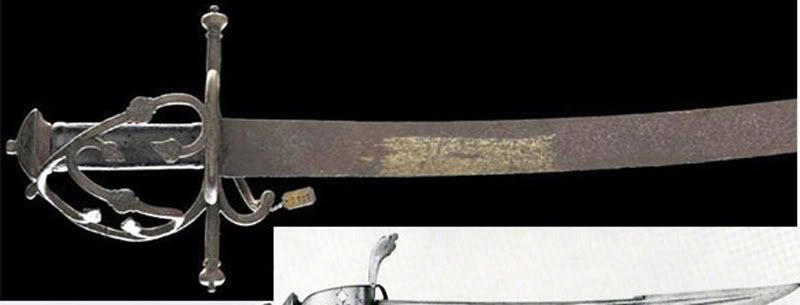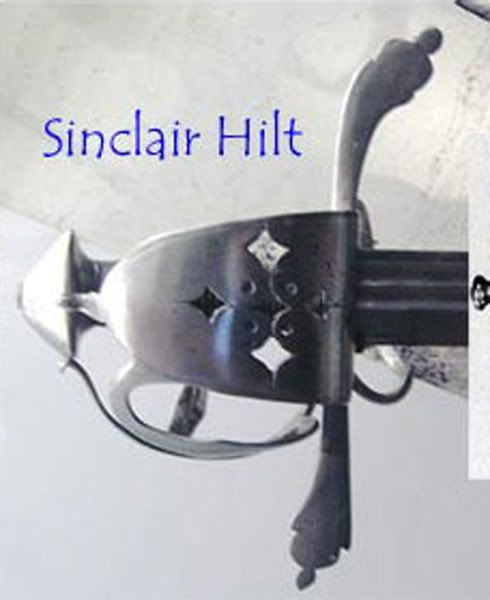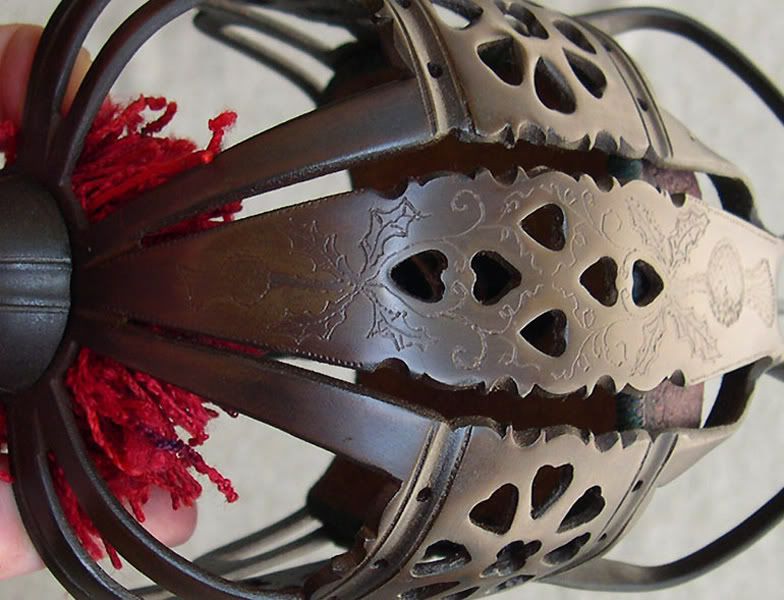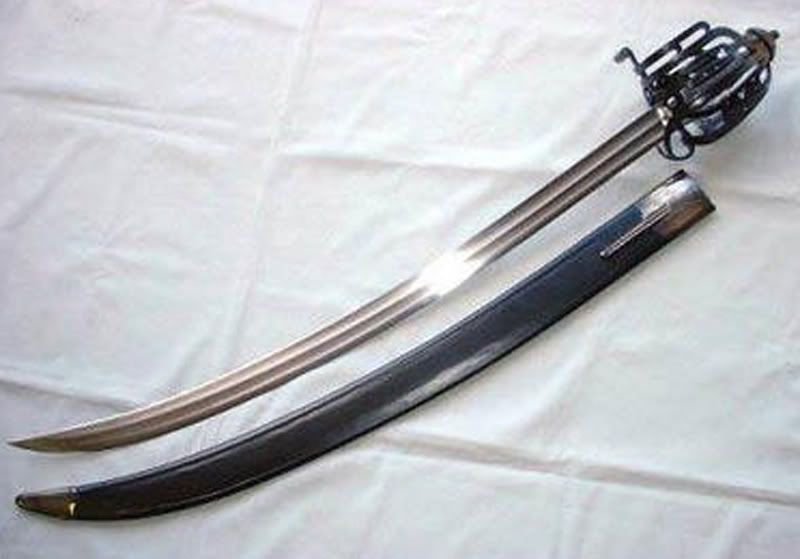|
-
11th February 09, 09:37 PM
#1
Some things never change.
-
-
12th February 09, 05:19 AM
#2
Great info here! I own three basket hilts: one broadsword and two backswords. My one backsword is a Mad Piper (Donnie Shearer) http://www.themadpiper.com/ My broadsword is marked Andrea Ferrara (not original, of course, but it's a good blade!!).
When doing Jacobite we all wear swords; doing F and I (Amercan Seven Years War) many of us wear them (they were beginning to lose their use and charm here in N. America among the Highland troops at that time) and for Rev. War, only Sjts. and higher rank will wear their swords (swords were put in stores when landing in NYC in 1776 because the musket had gained most prominence).
-
-
12th February 09, 09:17 PM
#3
Great illustrations Puffer.
For those who may not be up to speed, the SCHIAVONI are Slavs, from the region now known as Montenegro, who were employed as mercenaries by the Doge of Venice. By 1500 a sufficient number of them were living in Venice to warrant the building of an Orthodox Church, dedicated to St. Griorgio and St. Trifonio (now known as St. Giorgio dei Schiavoni). Arriving in Venice in the 1400s the Schiavoni brought with them their distinctive basket hilt broadswords, which quickly found favour through out much of Europe, including-- possibly-- the Scottish highlands.
Sword scholars have debated the evolution of the Scottish broadsword for more than a century, with as many declaring for the Schiavona as the precursor to the Scottish basket hilt as those who argue against it. It is my opinion that the Schiavona migrated north-westerly from Venice to Germany, beginning sometime in the 1400s, and from Germany the Schiavona made its way to Scotland. As the popularity of the broadsword increased, and the usefulness of the old, two handed, claymore waned, local artisans imported finished blades from Germany and made their own hilts which eventually evolved into the "classic" basket hilt of the 17th and 18th centuries.
Last edited by MacMillan of Rathdown; 14th February 09 at 08:51 AM.
-
-
13th February 09, 07:40 PM
#4
You guys have explained this very well. Thanks.
I am way better at the curvy ones. Though I do fancy having a go at this (basket hilt and double edged) one of these days, when I am not so far behind...
I rather like your opinion MacMillan. 
Swords are cool. You have a couple of very nice ones there, Puffer. The work from Armor Class is first rate !
-
-
13th February 09, 09:32 PM
#5
 Originally Posted by Howard Clark

You guys have explained this very well. Thanks.
I am way better at the curvy ones. Though I do fancy having a go at this (basket hilt and double edged) one of these days, when I am not so far behind...
I rather like your opinion MacMillan. 
Swords are cool. You have a couple of very nice ones there, Puffer. The work from Armor Class is first rate !
CURVED BLADE, NO PROBLEM' 'The Scots Highlanders had them & used them.
Here is an example of one "reportedly used by "Scots Mercenaries" during the "invasion of Norway in 1612. (Ger, style hilt)

The most common style hilt used was the "SINCLAIR" ( according to my info).

But the "standard Highland Hilt was also common later on Picture of a mid to late 1700s Hilt ( Saber bladed sword()

Puffer
-
-
14th February 09, 08:10 AM
#6
That's interesting... What book is that from ? I wonder what it weighs, and measures ? Does the book reference any of that information ?
I wonder where I could put my hands on one of the old ones like that to look at, and get the feel of ?
That's all I need, another thing to distract me from making the swords people have ordered already. 
I do find it interesting though. 
-
-
14th February 09, 09:33 AM
#7
 Originally Posted by Howard Clark

That's interesting... What book is that from ? I wonder what it weighs, and measures ? Does the book reference any of that information ?
I wonder where I could put my hands on one of the old ones like that to look at, and get the feel of ?
That's all I need, another thing to distract me from making the swords people have ordered already. 
I do find it interesting though. 
I wish I could be of more assistance. The pictures I have (& showed) are from my "picture collection" These have been collected over a span of years (Museum pics, Private collection pics, Auction Pics, & sites like "My Armory.com")
As to "getting your hands on an "original" lots of luck (of course it would be a GREAT reason to head to Europe for a Museum & privite collection "HUNT"
You could also head to a couple of the "Better" Sword shows.(to see "reproductions) Below are pictures from "VINCE EVANS" collection. I had the privilege of seeing this sword ( or one like it) a number of years ago.


Try to contact Vince Evans or as I advised before, hit the "My Armory" site
Puffer
-
-
14th February 09, 08:21 AM
#8
there's a small but good picture of a mid to late 1600s basket hilted sabre with very very good descriptions of length weight etc in the book Culloden: the swords and the sorrows. I'll get you the info when i dig the book off of my shelf later today. Figure 1:6
-
-
14th February 09, 07:05 PM
#9
I know Vince, though not well. I am hoping to see him in May at the Blade show. His work is always first rate as well. None better at accurate reproductions of historic swords. Though I would say Peter Johnsson is his equal on that score.
-
-
15th February 09, 09:36 AM
#10
 Originally Posted by Howard Clark

I know Vince, though not well. I am hoping to see him in May at the Blade show. His work is always first rate as well. None better at accurate reproductions of historic swords. Though I would say Peter Johnsson is his equal on that score.
Howard, if you make it to the SHOW, PLEASE TAKE PICTURES (Basket Hilts & Dagger/Dirks) & SHARE them. I would Humbly appreciate seeing them.
Puffer
-
 Posting Permissions
Posting Permissions
- You may not post new threads
- You may not post replies
- You may not post attachments
- You may not edit your posts
-
Forum Rules
|
|
Bookmarks